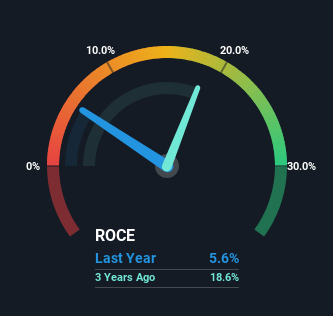Returns On Capital At Pioneer Embroideries (NSE:PIONEEREMB) Paint A Concerning Picture

What are the early trends we should look for to identify a stock that could multiply in value over the long term? In a perfect world, we'd like to see a company investing more capital into its business and ideally the returns earned from that capital are also increasing. Put simply, these types of businesses are compounding machines, meaning they are continually reinvesting their earnings at ever-higher rates of return. Having said that, from a first glance at Pioneer Embroideries (NSE:PIONEEREMB) we aren't jumping out of our chairs at how returns are trending, but let's have a deeper look.
What Is Return On Capital Employed (ROCE)?
For those that aren't sure what ROCE is, it measures the amount of pre-tax profits a company can generate from the capital employed in its business. Analysts use this formula to calculate it for Pioneer Embroideries:
Return on Capital Employed = Earnings Before Interest and Tax (EBIT) ÷ (Total Assets - Current Liabilities)
0.056 = ₹127m ÷ (₹3.3b - ₹1.0b) (Based on the trailing twelve months to June 2024).
So, Pioneer Embroideries has an ROCE of 5.6%. Ultimately, that's a low return and it under-performs the Luxury industry average of 11%.
Check out our latest analysis for Pioneer Embroideries

While the past is not representative of the future, it can be helpful to know how a company has performed historically, which is why we have this chart above. If you'd like to look at how Pioneer Embroideries has performed in the past in other metrics, you can view this free graph of Pioneer Embroideries' past earnings, revenue and cash flow.
The Trend Of ROCE
The trend of ROCE doesn't look fantastic because it's fallen from 10% five years ago, while the business's capital employed increased by 117%. However, some of the increase in capital employed could be attributed to the recent capital raising that's been completed prior to their latest reporting period, so keep that in mind when looking at the ROCE decrease. It's unlikely that all of the funds raised have been put to work yet, so as a consequence Pioneer Embroideries might not have received a full period of earnings contribution from it.
On a related note, Pioneer Embroideries has decreased its current liabilities to 31% of total assets. So we could link some of this to the decrease in ROCE. What's more, this can reduce some aspects of risk to the business because now the company's suppliers or short-term creditors are funding less of its operations. Since the business is basically funding more of its operations with it's own money, you could argue this has made the business less efficient at generating ROCE.
The Bottom Line
While returns have fallen for Pioneer Embroideries in recent times, we're encouraged to see that sales are growing and that the business is reinvesting in its operations. And the stock has done incredibly well with a 129% return over the last five years, so long term investors are no doubt ecstatic with that result. So while investors seem to be recognizing these promising trends, we would look further into this stock to make sure the other metrics justify the positive view.
Pioneer Embroideries does come with some risks though, we found 5 warning signs in our investment analysis, and 2 of those shouldn't be ignored...
While Pioneer Embroideries isn't earning the highest return, check out this free list of companies that are earning high returns on equity with solid balance sheets.
New: Manage All Your Stock Portfolios in One Place
We've created the ultimate portfolio companion for stock investors, and it's free.
• Connect an unlimited number of Portfolios and see your total in one currency
• Be alerted to new Warning Signs or Risks via email or mobile
• Track the Fair Value of your stocks
Have feedback on this article? Concerned about the content? Get in touch with us directly. Alternatively, email editorial-team (at) simplywallst.com.
This article by Simply Wall St is general in nature. We provide commentary based on historical data and analyst forecasts only using an unbiased methodology and our articles are not intended to be financial advice. It does not constitute a recommendation to buy or sell any stock, and does not take account of your objectives, or your financial situation. We aim to bring you long-term focused analysis driven by fundamental data. Note that our analysis may not factor in the latest price-sensitive company announcements or qualitative material. Simply Wall St has no position in any stocks mentioned.
About NSEI:PIONEEREMB
Pioneer Embroideries
Engages in the manufacture of special polyester filament yarn, embroidery, and lace products in India.
Proven track record with mediocre balance sheet.
Similar Companies
Market Insights
Community Narratives




